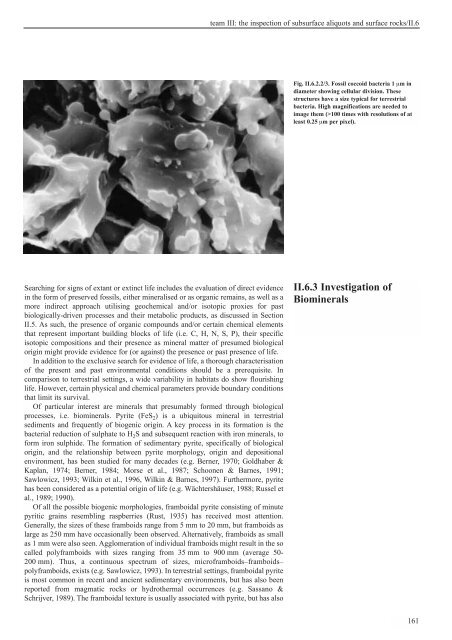Exobiology in the Solar System & The Search for Life on Mars - ESA
Exobiology in the Solar System & The Search for Life on Mars - ESA
Exobiology in the Solar System & The Search for Life on Mars - ESA
You also want an ePaper? Increase the reach of your titles
YUMPU automatically turns print PDFs into web optimized ePapers that Google loves.
<str<strong>on</strong>g>Search</str<strong>on</strong>g><str<strong>on</strong>g>in</str<strong>on</strong>g>g <str<strong>on</strong>g>for</str<strong>on</strong>g> signs of extant or ext<str<strong>on</strong>g>in</str<strong>on</strong>g>ct life <str<strong>on</strong>g>in</str<strong>on</strong>g>cludes <str<strong>on</strong>g>the</str<strong>on</strong>g> evaluati<strong>on</strong> of direct evidence<br />
<str<strong>on</strong>g>in</str<strong>on</strong>g> <str<strong>on</strong>g>the</str<strong>on</strong>g> <str<strong>on</strong>g>for</str<strong>on</strong>g>m of preserved fossils, ei<str<strong>on</strong>g>the</str<strong>on</strong>g>r m<str<strong>on</strong>g>in</str<strong>on</strong>g>eralised or as organic rema<str<strong>on</strong>g>in</str<strong>on</strong>g>s, as well as a<br />
more <str<strong>on</strong>g>in</str<strong>on</strong>g>direct approach utilis<str<strong>on</strong>g>in</str<strong>on</strong>g>g geochemical and/or isotopic proxies <str<strong>on</strong>g>for</str<strong>on</strong>g> past<br />
biologically-driven processes and <str<strong>on</strong>g>the</str<strong>on</strong>g>ir metabolic products, as discussed <str<strong>on</strong>g>in</str<strong>on</strong>g> Secti<strong>on</strong><br />
II.5. As such, <str<strong>on</strong>g>the</str<strong>on</strong>g> presence of organic compounds and/or certa<str<strong>on</strong>g>in</str<strong>on</strong>g> chemical elements<br />
that represent important build<str<strong>on</strong>g>in</str<strong>on</strong>g>g blocks of life (i.e. C, H, N, S, P), <str<strong>on</strong>g>the</str<strong>on</strong>g>ir specific<br />
isotopic compositi<strong>on</strong>s and <str<strong>on</strong>g>the</str<strong>on</strong>g>ir presence as m<str<strong>on</strong>g>in</str<strong>on</strong>g>eral matter of presumed biological<br />
orig<str<strong>on</strong>g>in</str<strong>on</strong>g> might provide evidence <str<strong>on</strong>g>for</str<strong>on</strong>g> (or aga<str<strong>on</strong>g>in</str<strong>on</strong>g>st) <str<strong>on</strong>g>the</str<strong>on</strong>g> presence or past presence of life.<br />
In additi<strong>on</strong> to <str<strong>on</strong>g>the</str<strong>on</strong>g> exclusive search <str<strong>on</strong>g>for</str<strong>on</strong>g> evidence of life, a thorough characterisati<strong>on</strong><br />
of <str<strong>on</strong>g>the</str<strong>on</strong>g> present and past envir<strong>on</strong>mental c<strong>on</strong>diti<strong>on</strong>s should be a prerequisite. In<br />
comparis<strong>on</strong> to terrestrial sett<str<strong>on</strong>g>in</str<strong>on</strong>g>gs, a wide variability <str<strong>on</strong>g>in</str<strong>on</strong>g> habitats do show flourish<str<strong>on</strong>g>in</str<strong>on</strong>g>g<br />
life. However, certa<str<strong>on</strong>g>in</str<strong>on</strong>g> physical and chemical parameters provide boundary c<strong>on</strong>diti<strong>on</strong>s<br />
that limit its survival.<br />
Of particular <str<strong>on</strong>g>in</str<strong>on</strong>g>terest are m<str<strong>on</strong>g>in</str<strong>on</strong>g>erals that presumably <str<strong>on</strong>g>for</str<strong>on</strong>g>med through biological<br />
processes, i.e. biom<str<strong>on</strong>g>in</str<strong>on</strong>g>erals. Pyrite (FeS 2) is a ubiquitous m<str<strong>on</strong>g>in</str<strong>on</strong>g>eral <str<strong>on</strong>g>in</str<strong>on</strong>g> terrestrial<br />
sediments and frequently of biogenic orig<str<strong>on</strong>g>in</str<strong>on</strong>g>. A key process <str<strong>on</strong>g>in</str<strong>on</strong>g> its <str<strong>on</strong>g>for</str<strong>on</strong>g>mati<strong>on</strong> is <str<strong>on</strong>g>the</str<strong>on</strong>g><br />
bacterial reducti<strong>on</strong> of sulphate to H 2S and subsequent reacti<strong>on</strong> with ir<strong>on</strong> m<str<strong>on</strong>g>in</str<strong>on</strong>g>erals, to<br />
<str<strong>on</strong>g>for</str<strong>on</strong>g>m ir<strong>on</strong> sulphide. <str<strong>on</strong>g>The</str<strong>on</strong>g> <str<strong>on</strong>g>for</str<strong>on</strong>g>mati<strong>on</strong> of sedimentary pyrite, specifically of biological<br />
orig<str<strong>on</strong>g>in</str<strong>on</strong>g>, and <str<strong>on</strong>g>the</str<strong>on</strong>g> relati<strong>on</strong>ship between pyrite morphology, orig<str<strong>on</strong>g>in</str<strong>on</strong>g> and depositi<strong>on</strong>al<br />
envir<strong>on</strong>ment, has been studied <str<strong>on</strong>g>for</str<strong>on</strong>g> many decades (e.g. Berner, 1970; Goldhaber &<br />
Kaplan, 1974; Berner, 1984; Morse et al., 1987; Scho<strong>on</strong>en & Barnes, 1991;<br />
Sawlowicz, 1993; Wilk<str<strong>on</strong>g>in</str<strong>on</strong>g> et al., 1996, Wilk<str<strong>on</strong>g>in</str<strong>on</strong>g> & Barnes, 1997). Fur<str<strong>on</strong>g>the</str<strong>on</strong>g>rmore, pyrite<br />
has been c<strong>on</strong>sidered as a potential orig<str<strong>on</strong>g>in</str<strong>on</strong>g> of life (e.g. Wächtershäuser, 1988; Russel et<br />
al., 1989; 1990).<br />
Of all <str<strong>on</strong>g>the</str<strong>on</strong>g> possible biogenic morphologies, framboidal pyrite c<strong>on</strong>sist<str<strong>on</strong>g>in</str<strong>on</strong>g>g of m<str<strong>on</strong>g>in</str<strong>on</strong>g>ute<br />
pyritic gra<str<strong>on</strong>g>in</str<strong>on</strong>g>s resembl<str<strong>on</strong>g>in</str<strong>on</strong>g>g raspberries (Rust, 1935) has received most attenti<strong>on</strong>.<br />
Generally, <str<strong>on</strong>g>the</str<strong>on</strong>g> sizes of <str<strong>on</strong>g>the</str<strong>on</strong>g>se framboids range from 5 mm to 20 mm, but framboids as<br />
large as 250 mm have occasi<strong>on</strong>ally been observed. Alternatively, framboids as small<br />
as 1 mm were also seen. Agglomerati<strong>on</strong> of <str<strong>on</strong>g>in</str<strong>on</strong>g>dividual framboids might result <str<strong>on</strong>g>in</str<strong>on</strong>g> <str<strong>on</strong>g>the</str<strong>on</strong>g> so<br />
called polyframboids with sizes rang<str<strong>on</strong>g>in</str<strong>on</strong>g>g from 35 mm to 900 mm (average 50-<br />
200 mm). Thus, a c<strong>on</strong>t<str<strong>on</strong>g>in</str<strong>on</strong>g>uous spectrum of sizes, microframboids–framboids–<br />
polyframboids, exists (e.g. Sawlowicz, 1993). In terrestrial sett<str<strong>on</strong>g>in</str<strong>on</strong>g>gs, framboidal pyrite<br />
is most comm<strong>on</strong> <str<strong>on</strong>g>in</str<strong>on</strong>g> recent and ancient sedimentary envir<strong>on</strong>ments, but has also been<br />
reported from magmatic rocks or hydro<str<strong>on</strong>g>the</str<strong>on</strong>g>rmal occurrences (e.g. Sassano &<br />
Schrijver, 1989). <str<strong>on</strong>g>The</str<strong>on</strong>g> framboidal texture is usually associated with pyrite, but has also<br />
team III: <str<strong>on</strong>g>the</str<strong>on</strong>g> <str<strong>on</strong>g>in</str<strong>on</strong>g>specti<strong>on</strong> of subsurface aliquots and surface rocks/II.6<br />
Fig. II.6.2.2/3. Fossil coccoid bacteria 1 µm <str<strong>on</strong>g>in</str<strong>on</strong>g><br />
diameter show<str<strong>on</strong>g>in</str<strong>on</strong>g>g cellular divisi<strong>on</strong>. <str<strong>on</strong>g>The</str<strong>on</strong>g>se<br />
structures have a size typical <str<strong>on</strong>g>for</str<strong>on</strong>g> terrestrial<br />
bacteria. High magnificati<strong>on</strong>s are needed to<br />
image <str<strong>on</strong>g>the</str<strong>on</strong>g>m (>100 times with resoluti<strong>on</strong>s of at<br />
least 0.25 µm per pixel).<br />
II.6.3 Investigati<strong>on</strong> of<br />
Biom<str<strong>on</strong>g>in</str<strong>on</strong>g>erals<br />
161

















